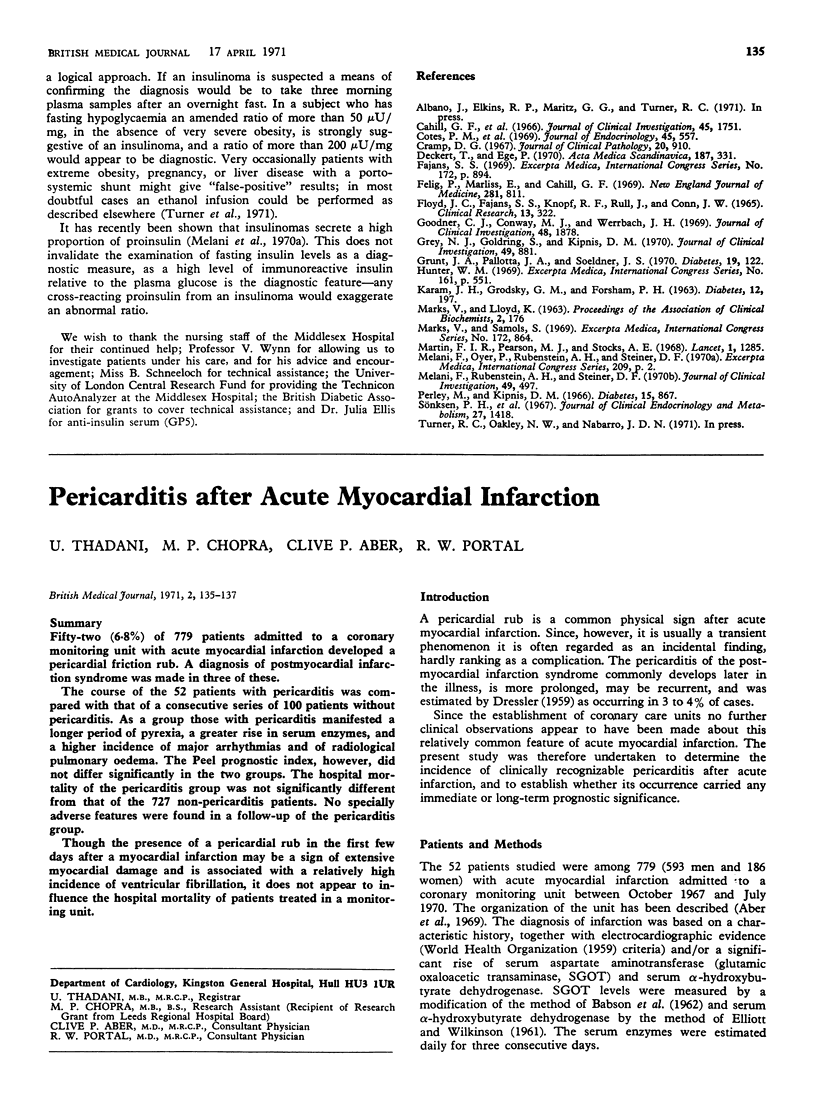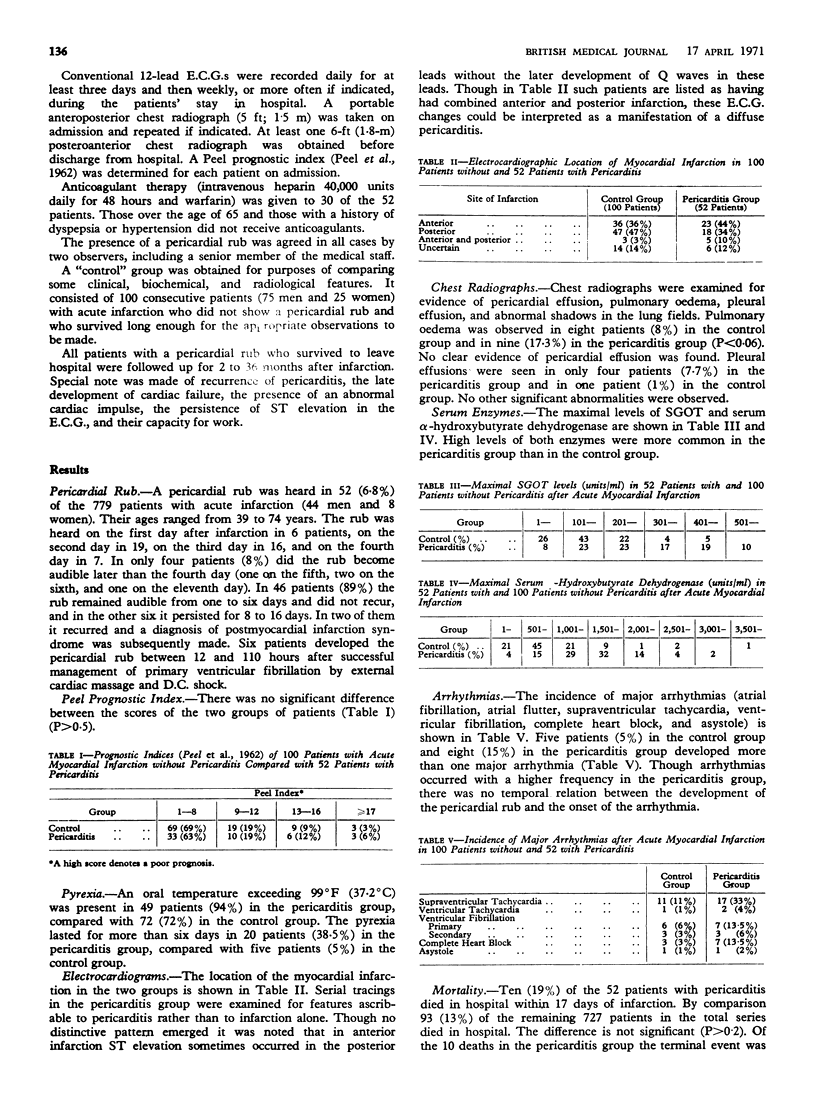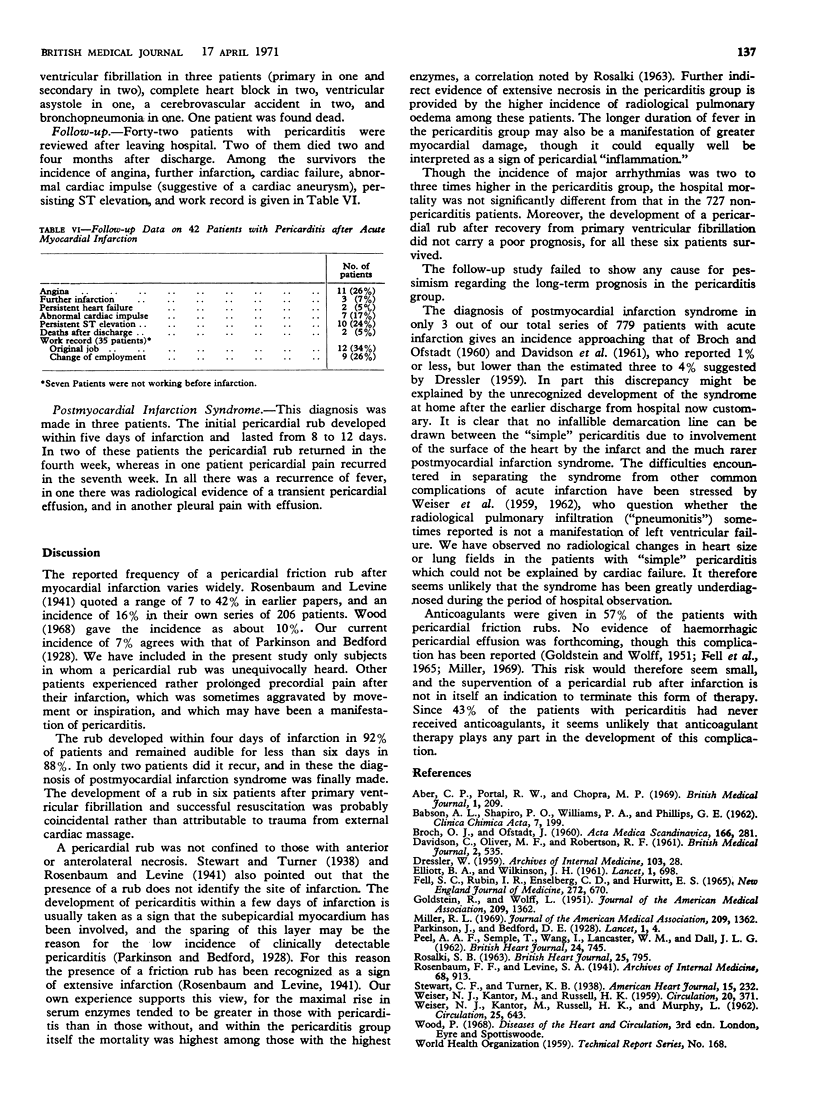Abstract
Fifty-two (6·8%) of 779 patients admitted to a coronary monitoring unit with acute myocardial infarction developed a pericardial friction rub. A diagnosis of postmyocardial infarction syndrome was made in three of these.
The course of the 52 patients with pericarditis was compared with that of a consecutive series of 100 patients without pericarditis. As a group those with pericarditis manifested a longer period of pyrexia, a greater rise in serum enzymes, and a higher incidence of major arrhythmias and of radiological pulmonary oedema. The Peel prognostic index, however, did not differ significantly in the two groups. The hospital mortality of the pericarditis group was not significantly different from that of the 727 non-pericarditis patients. No specially adverse features were found in a follow-up of the pericarditis group.
Though the presence of a pericardial rub in the first few days after a myocardial infarction may be a sign of extensive myocardial damage and is associated with a relatively high incidence of ventricular fibrillation, it does not appear to influence the hospital mortality of patients treated in a monitoring unit.
Full text
PDF


Selected References
These references are in PubMed. This may not be the complete list of references from this article.
- Aber C. P., Portal R. W., Chopra M. P. Cardiac monitoring in a regional hospital. Br Med J. 1969 Jan 25;1(5638):209–212. doi: 10.1136/bmj.1.5638.209. [DOI] [PMC free article] [PubMed] [Google Scholar]
- BABSON A. L., SHAPIRO P. O., WILLIAMS P. A., PHILLIPS G. E. The use of a diazonium salt for the determination of glutamic-oxalacetic transaminase in serum. Clin Chim Acta. 1962 Mar;7:199–205. doi: 10.1016/0009-8981(62)90010-4. [DOI] [PubMed] [Google Scholar]
- BROCH O. J., OFSTAD J. The post-myocardial-infarction syndrome. Acta Med Scand. 1960 Mar 30;166:281–290. doi: 10.1111/j.0954-6820.1960.tb17380.x. [DOI] [PubMed] [Google Scholar]
- DAVIDSON C., OLIVER M. F., ROBERTSON R. F. Post-myocardial-infarction syndrome. Br Med J. 1961 Aug 26;2(5251):535–539. doi: 10.1136/bmj.2.5251.535. [DOI] [PMC free article] [PubMed] [Google Scholar]
- DRESSLER W. The post-myocardial-infarction syndrome: a report on forty-four cases. AMA Arch Intern Med. 1959 Jan;103(1):28–42. doi: 10.1001/archinte.1959.00270010034006. [DOI] [PubMed] [Google Scholar]
- ELLIOTT B. A., WILKINSON J. H. Serum "alpha-hydroxybutyric dehydrogenase" in myocardial infarction and in liver disease. Lancet. 1961 Apr 1;1(7179):698–699. doi: 10.1016/s0140-6736(61)91724-x. [DOI] [PubMed] [Google Scholar]
- FELL S. C., RUBIN I. L., ENSELBERG C. D., HURWITT E. S. ANTICOAGULANT-INDUCED HEMOPERICARDIUM WITH TAMPONADE: ITS OCCURRENCE IN THE ABSENCE OF MYOCARDIAL INFARCTION OR PERICARDITIS. N Engl J Med. 1965 Apr 1;272:670–674. doi: 10.1056/NEJM196504012721305. [DOI] [PubMed] [Google Scholar]
- Miller R. L. Hemopericardium with use of oral anticoagulant therapy. JAMA. 1969 Sep 1;209(9):1362–1364. [PubMed] [Google Scholar]
- Peel A. A., Semple T., Wang I., Lancaster W. M., Dall J. L. A CORONARY PROGNOSTIC INDEX FOR GRADING THE SEVERITY OF INFARCTION. Br Heart J. 1962 Nov;24(6):745–760. doi: 10.1136/hrt.24.6.745. [DOI] [PMC free article] [PubMed] [Google Scholar]
- ROSALKI S. B. SERUM ALPHA-HYDROXYBUTYRATE DEHYDROGENASE: A NEW TEST FOR MYOCARDIAL INFARCTION. Br Heart J. 1963 Nov;25:795–802. doi: 10.1136/hrt.25.6.795. [DOI] [PMC free article] [PubMed] [Google Scholar]
- WEISER N. J., KANTOR M., RUSSELL H. K., MURPHY L. The postmyocardial infarction syndrome. The nonspecificity of the pulmonary manifestations. Circulation. 1962 Apr;25:643–650. doi: 10.1161/01.cir.25.4.643. [DOI] [PubMed] [Google Scholar]
- WEISER N. J., KANTOR M., RUSSELL H. K. Postmyocardial infarction syndrome. Circulation. 1959 Sep;20:371–380. doi: 10.1161/01.cir.20.3.371. [DOI] [PubMed] [Google Scholar]


